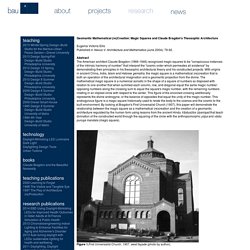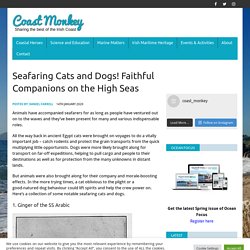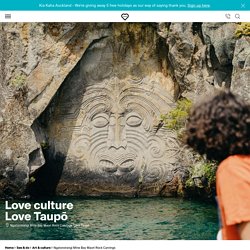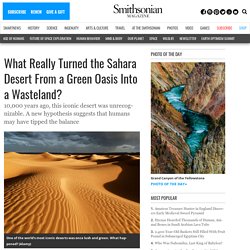

Eugenia Victoria Ellis - Geomantic (Re)Creation: Magic Squares And Claude Bragdon's Theosophic Architecture. Eugenia Victoria EllisDepartment of Design, College of Media Arts and DesignDrexel University, Philadelphia, Pennsylvania, USA The American architect Claude Bragdon (1866-1946) recognized magic squares to be "conspicuous instances of the intrinsic harmony of number" that interpret the "cosmic order which permeates all existence" by demonstrating their principles in his constructed projects.

With origins in ancient China, India, Islam and Hebrew gematria, the magic square is a mathematical procedure that is both an operation of the architectural imagination and a geomantic projection from the divine. BAU Architecture. Geomantic Mathematical (re)Creation: Magic Squares and Claude Bragdon's Theosophic Architecture Eugenia Victoria Ellis Published in Nexus V: Architecture and Mathematics (June 2004): 79-92.

Abstract The American architect Claude Bragdon (1866-1946) recognized magic squares to be "conspicuous instances of the intrinsic harmony of number" that interpret the "cosmic order which permeates all existence" by demonstrating their principles in his theosophic architectural theory and his constructed projects.
With origins in ancient China, India, Islam and Hebrew gematria, the magic square is a mathematical (re)creation that is both an operation of the architectural imagination and a geomantic projection from the divine. Gematria value of magic squares is 586 - English, Hebrew and Simple Gematria Calculator Values. Magic Squares and Gematria: Mystical Codes : Snow Cone Diaries. Seafaring Cats and Dogs! Faithful Companions on the High Seas – Coast Monkey. Animals have accompanied seafarers for as long as people have ventured out on to the waves and they’ve been present for many and various indispensable roles.

All the way back in ancient Egypt cats were brought on voyages to do a vitally important job – catch rodents and protect the grain transports from the quick multiplying little opportunists. Dogs were more likely brought along for transport on far-off expeditions, helping to pull cargo and people to their destinations as well as for protection from the many unknowns in distant lands. But animals were also brought along for their company and morale-boosting effects. In the more trying times, a cat oblivious to the plight or a good-natured dog behaviour could lift spirits and help the crew power on.
Ngatoroirangi Mine Bay Maori Rock Carvings. When traditional marae-taught carver Matahi Brightwell paddled past a rock alcove on Lake Taupo in 1976, he had a vision of a tattooed face.

His grandmother, Te Huatahi Susie Gilbert of Ngati Rauhoto, Ngati Tuwharetoa, Ngati Maiotaki and Ngati Whakaue, had asked the young carver to create a likeness of her ancestor Ngatoroirangi on a totara tree to create a permanent connection for her family to the land. When Matahi arrived in Taupo there was no totara tree to carve so he journeyed onto the lake for inspiration. The rock alcove at Mine Bay became the canvas for one of the most extraordinary contemporary artworks New Zealand has ever seen. Portal de Aramu Muru. L. Kendall K2, the mutinty of the Bounty and Captain Bligh. The K1 chronometer was such a great success that the Board of Longitude decided to outfit each of her Majesty’s ships with one.

However the price of the K1 was prohibitively expensive at £400 - the cost of a whole ship at the time (such as the HMS Resolution) was £1800! So Kendall proposed constructing a less expensive, less sophisticated version of the K1 chronometer, but based on the same principles. His proposal was accepted and he completed the K2 in early 1772. The K2 was given to Captain John Phillips who took it on his expedition in search of the Northwest Passage and in 1787 William Bligh in command of HMS Bounty, took it on board his ship. Agartha, ¿es la sede de un gobierno sinárquico que ejerce el poder real en la Tierra? « Oldcivilizations's Blog.
Rosicrucian Movement. In 1614 the publication of the Fama Fraternitatis announced the existence of a fraternity devoted to the spiritual life, to the reform and advancement of learning, and to magic.

This anonymous document did not fall onto stony ground. Previously, Emperor Rudolf II, though a Hapsburg, had immersed himself in alchemical studies in Prague. León el Africano. Valentine 'Azoth' series coloured. Untitled. Rosicrucian Thoughts on the Ever-Burning Lamps of the Ancients. Transcribed by Eric O'Dell.

Rosicrucian Thoughts on the Ever-Burning Lamps of the Ancients. By W. The Rosicrucians : their rites and mysteries : Jennings, Hargrave, 1817?-1890 : Free Download, Borrow, and Streaming. Abraxas. Magic. The fruit tree blossom in Sinai. While it might be quite cold in the Sinai high mountains up until March, the almond trees in the wadis start to blossom as early as January.

They are followed by apricot and other fruit species, finishing with apple, pear and pomegranate. Until June you always find some trees in blossom. And just as it takes about half a year for all the fruit species to blossom, you always have some fruit ready to eat from May to as late as October. And it’s only a little time before the cycle starts over again. There are hundreds of gardens in the wadis in the mountains. The fruit tree blossom in Sinai. Deep inside Earth, scientists find weird blobs and mountains taller than Mount Everest. Inner Earth Is Teeming With Exotic Forms of Life. Ancient bacteria from nearly two miles below Earth's surface: that's what first drew Tullis Onstott to begin his search for life in the most unlikely of places.

The geomicrobiologist had just attended a 1992 U.S. Department of Energy meeting about rocks estimated to be more than 200 million years old—older than most dinosaurs. World's Largest Cave. QR32pamphletpdf. What Really Turned the Sahara Desert From a Green Oasis Into a Wasteland? When most people imagine an archetypal desert landscape—with its relentless sun, rippling sand and hidden oases—they often picture the Sahara.

But 11,000 years ago, what we know today as the world’s largest hot desert would’ve been unrecognizable. The now-dessicated northern strip of Africa was once green and alive, pocked with lakes, rivers, grasslands and even forests. So where did all that water go? African humid period. Holocene climate period during which northern Africa was wetter than today The Sahara was not a desert during the African humid period. Instead, most of northern Africa was covered by grass, trees, and lakes. The African humid period (AHP, also known as the Neolithic Subpluvial, as well as by other names) is a climate period in Africa during the late Pleistocene and Holocene geologic epochs, when northern Africa was wetter than today. ‘Our biggest challenge? Lack of imagination’: the scientists turning the desert green. Flying into Egypt in early February to make the most important presentation of his life, Ties van der Hoeven prepared by listening to the podcast 13 Minutes To The Moon – the story of how Nasa accomplished the lunar landings.
The mission he was discussing with the Egyptian government was more earthbound in nature, but every bit as ambitious. It could even represent a giant leap for mankind. Van der Hoeven is a co-founder of the Weather Makers, a Dutch firm of “holistic engineers” with a plan to regreen the Sinai peninsula – the small triangle of land that connects Egypt to Asia. Within a couple of decades, the Weather Makers believe, the Sinai could be transformed from a hot, dry, barren desert into a green haven teeming with life: forests, wetlands, farming land, wild flora and fauna.
Hang Sơn Đoòng. Sơn Đoòng cave (Vietnamese: hang Sơn Đoòng, IPA: [haːŋ˧ ʂəːn˧ ɗɔ̤ŋ˨˩]), in Phong Nha-Kẻ Bàng National Park, Bố Trạch District, Quảng Bình Province, Vietnam, is one of the world's largest natural caves.[1] Located near the Laos–Vietnam border, Hang Sơn Đoòng has an internal, fast-flowing subterranean river and the largest cross-section of any cave, worldwide, as of 2009,[2][3] believed to be twice that of the next largest passage.
It is the largest known cave passage in the world by volume. Its name, Hang Sơn Đoòng, is variously translated from Vietnamese as 'cave of the mountain river'[4] or 'cave of mountains behind Đoòng [village]'. [disputed ] Fly Through A Colossal Cave: Son Doong in 360° Son Doong is one of the world's largest caves, with enormous chambers that can comfortably fit a 747 airplane or an entire New York City block full of 40-story buildings. Its mammoth chambers extend so far that explorers have called Son Doong an "infinite cave. " And with an amazing new digital tour, you can plunge below ground to see it yourself without ever leaving the country. Pictures have offered stunning peeks into the cave, which is located in central Vietnam's Phong Nha-Ke Bang National Park, since explorers discovered it in 2009 with the help of a local guide.
But the attention of curious sightseers is a double-edged sword; planned construction projects to make the cave more accessible to tourists could harm the formation's unique environment. Photojournalist Martin Edström hopes to bring the cave to as many people as possible. Why was the captain of the Bounty so desperate to save the ship's chronometer? Timepiece that held the key to the most infamous mutiny in British naval history. Why was the captain of the Bounty so desperate to save the ship's chronometer? Timepiece that held the key to the most infamous mutiny in British naval history Captain William Bligh was kicked off the Bounty by mutinous crew in 1789During revolt, he pleaded to keep hold of K2, the ship's chronometerBut mutineers refused to hand it over and used it to flee to Pitcairn IslandNew letter reveals how Bligh had to admit to the Admiralty it had been lost By Steve Robson Published: 06:45 EDT, 18 July 2013 | Updated: 08:08 EDT, 18 July 2013 Valued: K2, the maritime time-keeping device, used by Captain William Bligh on board the Bounty.
Publicdomainreview. Definition, History, & Facts. Rebis. Teúrgia. Christian Rosenkreuz. The Triangular Book of St. Germain. Manly Palmer Hall collection of alchemical manuscripts, 1500-1825 : Hall, Manly P. (Manly Palmer), 1901-1990 : Free Download, Borrow, and Streaming. Manly Palmer Hall collection of alchemical manuscripts, 1500-1825 : Hall, Manly P. (Manly Palmer), 1901-1990 : Free Download, Borrow, and Streaming. Allan Kardec.